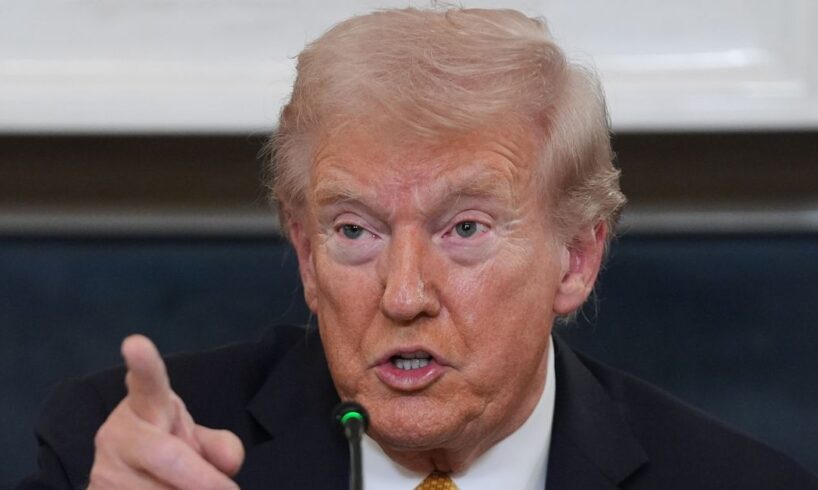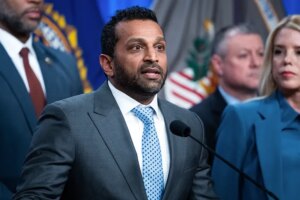
President Donald Trump is still talking about trying to seek a third term in 2028, despite that being blatantly unconstitutional.
After Trump ally Steve Bannon suggested last week that some kind of plan was in place for the president to run again, Trump overnight downplayed the idea of running as vice president but otherwise left his options open.
“I would love to do it. I have the best numbers ever,” Trump told reporters aboard Air Force One when asked about the possibility, while falsely claiming his poll numbers are at a high point. Pressed further, Trump said: “Am I not ruling it out? You’ll have to tell me.”
Constitutionally, Donald Trump is barred from running again as President. (AP)
So what to make of his latest noncommittal comments about this matter?
It would be foolish to completely dismiss it.
This is a president, after all, who has shown increasingly little regard for the legal barriers in front of him. This is also a president who, less than five years ago, attempted to overturn an election based on lies about voter fraud.
Plenty back then dismissed it as unthinkable that Trump would go to such lengths to stay in office (remember Mick Mulvaney’s op-ed?) And there are plenty of examples of Trump doing things that people wagered were just trolling.
But even if Trump has no plans to seek a third term in 2028, when he’d be 82, he has plenty of reason to keep talking about the possibility — even beyond his affinity for trolling.
That’s because it helps him stave off something that is looming increasingly large: lame-duck status.
Donald Trump’s planned remodelling of the White House shows he wants to stamp his legacy long after he leaves the presidency. (AP)
To the extent people even think there is a chance Trump could stick around beyond January 2029, that plays into his hands. And that arguably matters more to Trump than to your average president, given his demonstrated interest in trying to consolidate power.
The term “lame duck” is most often used to refer to the brief period between an election and the inauguration of the new president-elect. It’s during this period when the outgoing president is both freed up politically to try to do things — like controversial pardons — but is also constrained politically because everyone knows they’re a short-timer who won’t have to be dealt with for much longer.
This dynamic also applies in certain ways to second-term presidents, who are constitutionally barred from running again, which means eventually everyone starts making plans for a reality that won’t include him.
“The Twenty-second Amendment ensures that a reelected president becomes a lame duck, contributing to the diminution of the office in the view of other Washington institutions,” political scientists John C. Fortier and Norman J. Ornstein wrote for the Brookings Institution in 2016.
Fortier and Ornstein added that this dynamic becomes even more acute around midterm elections — which, in Trump’s case, are a little more than a year away — when the party that controls the White House typically loses seats.
“The willingness to get distance from the president — and to intensify that distance if he suffers public disapproval — increases geometrically,” they wrote about lawmakers in Congress from the president’s party.
Donald Trump’s popularity with Republican voters is immense, and not like any previous Republican president. (AP)
Trump is, as he usually is, a special case. The idea that Republicans would ever truly distance themselves from him seems ridiculous, given he dominates his party like few, if any, modern presidents have.
But there have arguably been signs of Republicans and even some allies of the president preparing themselves for a political reality that is no longer centred on Trump.
Republican Representative Marjorie Taylor Greene of Georgia, for example, seems to be trying to carve out an even-more-populist MAGA lane on things like Obamacare subsidies and the Jeffrey Epstein files. The Bulwark’s Will Sommer also wrote recently about how some in the MAGA media ecosystem seem to be preparing for life after Trump.
And given his presidency has often been rather ideologically fluid, there will be fighting over what direction the MAGA movement goes from here. Consider something like foreign policy: Trump has certainly taken things in a more interventionist direction in his second term than his “America First” platform.
So does the movement continue in that direction (like Marco Rubio) or revert to more of a first-term, isolationist posture (like JD Vance)? Trump name-dropped both men when asked about the “good people” he has in mind for the GOP ticket in 2028.
Protesters are taking to American streets to fight against some of Donald Trump’s measures. (AP)
The potential lame-duck dynamic also matters more with Trump than your average president. That’s because his ability to keep and maintain power is built on fears about his willingness to make his critics pay. We’ve seen a steady progression of institutions simply cave to Trump rather than fight even what would seem to be winnable legal battles.
But what happens when the end of his term is approaching and people know he’ll soon have less power to enforce his power plays? At that point, there becomes more of a premium on just waiting him out — if not a fear of what things might be like when the shoe is on the other foot, and Democrats have power.
So what Trump and allies like Bannon are effectively doing is planting a seed in people’s minds that says: What if you don’t actually know he’ll be gone come January 2029?
That doesn’t mean this is a serious proposal. It strains credulity how Trump would ever make this a reality, even if he wanted to.
But we’re probably doomed to keep hearing about it for as long as the notion is useful for Trump.





